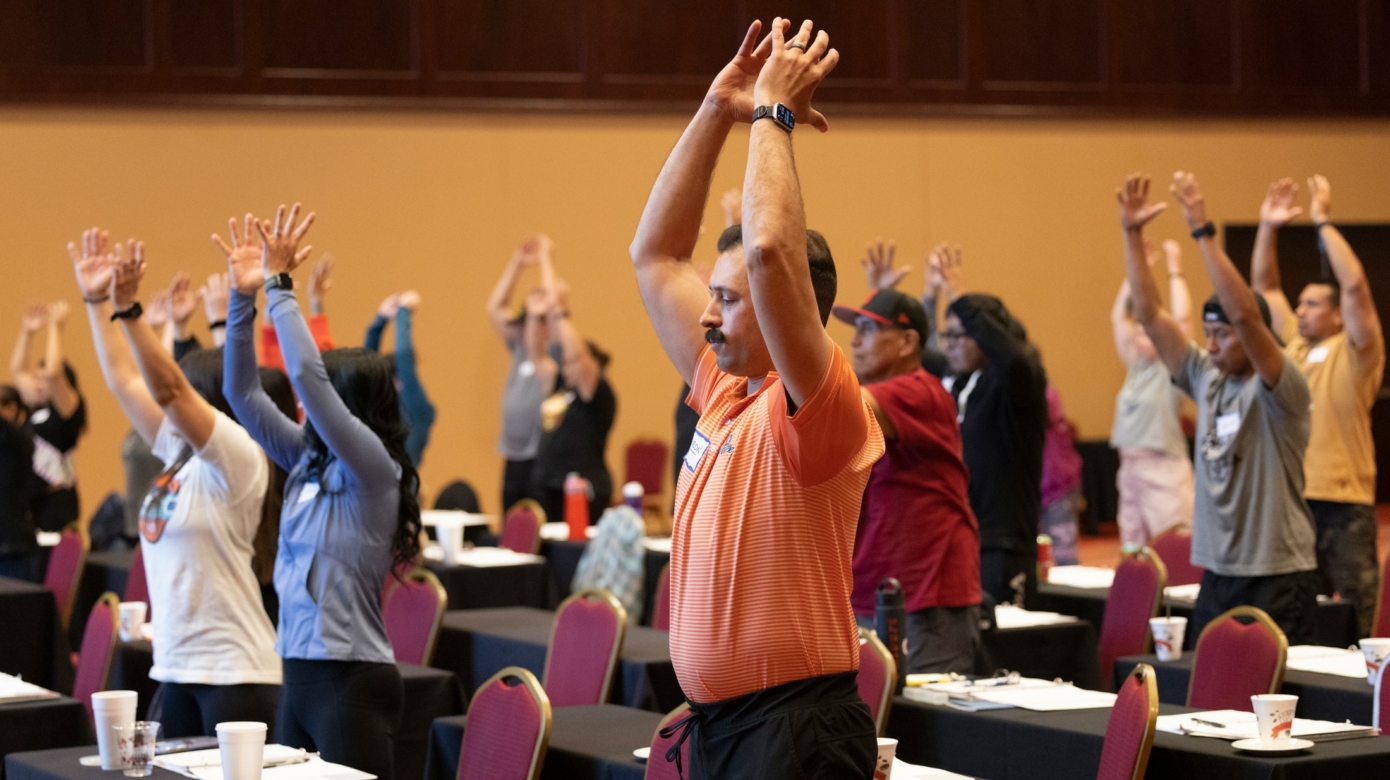Fitness professionals from across the United States attended an event designed to help them improve the overall wellness of the Native American communities they serve.
The Native American Fitness Council held a conference at the Grand Casino Hotel & Resort April 18-21 so participants could receive certifications in medical conditions and exercise. Citizen Potawatomi Nation Health Services sponsored the event.
The NAFC was established in 2004 to empower Native Americans through exercise education. Its goals include helping increase the number of Native American fitness instructors as well as teaching fitness professionals to train Native Americans in exercise techniques and achieving a healthy lifestyle.
Conference topics included chronic disease and exercise, relaxation and balance exercises, physical effects of aging on individuals, how to start an elder exercise program and more. CPN Wellness Center employees attended the conference and received certification.
“The majority of the people we work with are Native Americans,” said Leslie Cooper, CPN Wellness Center director. “A lot of Native American communities are traditional and very culture based. The classes we offer (respect) cultural and traditional ways more than you would in a typical gym setting.”
Conference attendees discussed how to meet the unique health and wellness needs of their respective Indigenous communities and participated in hands-on exercises they can share with the people they serve, said Brian Laban (Hopi/Tewa), NAFC executive advisor and board member.
Training clients
Fitness training often involves memorizing technical terms, but that terminology does not always apply to the day-to-day reality of training people. Laban said NAFC focuses on the information trainers need to more effectively help their clients.
“We want people to use that simple, applicable language,” he said. “If you say, ‘Raise your arm to the side,’ people understand that instead of using technical language. We give (trainers) the core concepts of exercise, how to set things up, and from there, they can start adding to it.”
Some people exercise hoping to maintain their health or to avoid health issues. Others with chronic health conditions are often advised by their doctors to start exercising and may not know how to begin. Cooper said trainings like the one the NAFC provided will help her staff assist clients who have diabetes, cancer, osteoporosis or several other chronic conditions.
Laban said the NAFC works with trainers of all types of experience to help them tailor their approach to their client. Working with youth or with an athlete requires a different approach than working with an elder.
“We’ve had people with their master’s in kinesiology and biomechanics tell us, ‘They’ve never taught us this before.’ But book learning and practical learning are a little bit different,” he said. “We hope to make fitness concepts and techniques applicable for every day.”
By making fitness accessible, Laban said more people will be inclined to participate in programs or visit a fitness facility. He wants people to know they do not have to “get in better shape before they visit the gym.”
“I think everybody’s starting to understand, ‘Come and let us help give you different ideas.’ The main goal is keeping (clients) safe and teaching them how to do things correctly so their lives can get better,” he said.
In addition to improving physical fitness, NAFC advocates for supporting emotional and spiritual wellness. Laban recalled a client who was injured after a fall and then became homebound. The experience caused her to lose confidence and feel guilty about how her condition affected her family.
“We did help her physically with strength, balance, endurance, flexibility, agility. All of this improved, but she gradually gained her independence and her confidence back. That was huge. Sometimes it’s not just about helping (clients) physically,” he said.
Future collaboration
Laban met Cooper at a previous NAFC training where Cooper expressed interest in hosting the organization at CPN.
NAFC is always interested in visiting other tribal communities so their membership can network with peers. The NAFC is based in Colorado, but its members are located across the U.S. CPN’s central location made it easy for everyone to attend, Laban said. This year, members from as far as Maine, California and Florida traveled to the conference.
The council is looking forward to collaborating with CPN again. They hope to develop an agreement for the CPN Wellness Center to be one of NAFC’s official training sites, Laban said. Currently, the Mille Lacs Band Ojibwe in Onamia, Minnesota, is the only other site with an official designation from the NAFC.
With an official training site designation and its central location, CPN could host future NAFC events, making it more convenient for fitness trainers to attend and learn new skills, Cooper said.
She believes the variety of NAFC programs may help increase the number of fitness trainers who work with Native American populations.
“They have a certified personal trainer class, a group fitness instructor class, classes for special medical conditions. They also focus on exercise and aging. As an official site, (NAFC) would be able to come and offer different (classes) at different times of the year,” she said, making the certification process easier for trainers.
For more information, visit the NAFC at nativeamericanfitnesscouncil.com. To learn more about starting a fitness plan, visit the CPN Wellness Center online at cpn.news/wellness or contact them at 405-395-9304.

